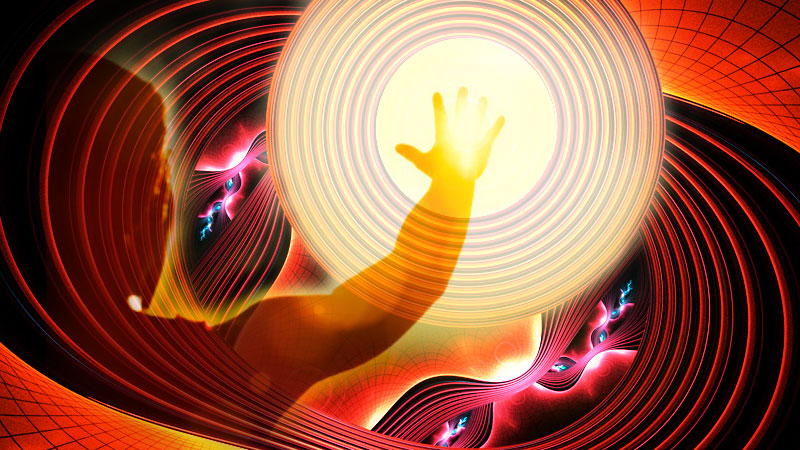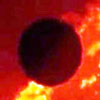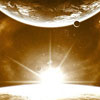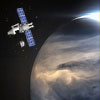Loma, Citizen of Venus: The Sun Is Not Hot
“I wish to ask you a few more questions, Loma.
“You have stated that the sun does not radiate light or heat. I should infer, therefore, that the sun, like this earth, is a world, perhaps having substantially similar physical characteristics, and only differing from this earth in the fact of being older and larger by growth, as earthly parents are older and larger by growth than their infant progeny. Am I correct?”
“Precisely.”
“How, then, do you account for the phenomena of light and heat which seem to be developed by the sun’s rays as soon as he rises above the horizon?”
“You, of course, understand, from what I have already said, that the sun, being a living organ, composed of matter, is radiating constantly an emanation of magnetism, which, having a natural affinity for space, penetrates space as far as his influence is capable of making itself felt. Of course a certain amount of this magnetism strikes that side of the earth which is presented to the sun.”
“Certainly.”
“Now, coldness is the phenomenon of electricity and composure. Hotness is the phenomenon of magnetism and fervency. Darkness is the phenomenon of receptivity and gravity, while light is the phenomenon of radiation and vibration. To be more explicit, in the ratio in which electricity and composure dominate over magnetism and fervency, we have coldness as a result; hence it is colder on that side of the earth which is turned away from the sun, because there is no magnetism striking that side, and it is in a state of composure. On the other side, that is, the side next to the sun, the rays of magnetism are striking the atmosphere of the earth and penetrating to its surface, and we have magnetism dominating over electricity, and heat is produced, and it is more intense as the ray is more vertical or direct. The heat, therefore, which our consciousness ascribes to the sun is really generated in the atmosphere of the earth, by the magnetism of the sun striking a resisting medium. The proof of this is found in the fact that the higher we ascend into the atmosphere of the earth the colder it becomes, because as the atmosphere becomes more rare the sun ray is less restrained. Beyond the outer atmospheric limits, heat is impossible until another atmosphere is reached.
“Darkness is exhibited in the ratio that receptivity and gravity dominate over radiation and vibration. Conversely, light is exhibited in the ratio in which radiation and vibration dominate over receptivity and gravity. Consequently, on that side of the earth upon which we have the radiation of the sun’s magnetism, and the vibrations of the atmosphere caused thereby we have light. Beyond the outer limits of the atmosphere, light is as impossible as heat, until another atmosphere is reached.
“This explains why, as I have said, there is no reason for supposing that the sun is a blazing mass. This conception grows out of the impression produced upon the consciousness, which is a totally unreliable guide. It is just as absurd to believe that the earth is fiat, yet, until science proved the contrary, such was the universal belief.”
“Recent experiments have certainly shown, that the higher we go in balloon ascensions, and the closer we get to the outer limits of the atmosphere, the darker and colder it becomes,”‘ said the doctor.
“Certainly,” said Loma. “Now, if the observer at high altitude had a mirror, if your commonly accepted hypothesis were correct, he should be able to reflect as bright an image of the sun as he can at the surface of the earth. We know this is not the case; and if he were beyond the outer limits of the atmosphere, he could not get any image at all, for under such conditions light and heat are both impossible.”
“But,” said the doctor musingly, “if such is the case, how does it happen that light is developed on the surface of the moon which has no atmosphere?”
“There is no light or heat from the sun, developed on the moon. The rays of the sun’s magnetism which strike the surface of the moon are reflected to this earth, and passing into our atmosphere produce light, which enables us to form an image of the moon. But if an observer could be translated to the center of the apparently illuminated surface of the moon, he would find himself in total darkness and absolute cold, as far as the sun is concerned. All the heat which the moon has is internal heat generated by its own fervency of magnetic passion, which is very small comparatively until it passes from incubation to actual activity. Then it will form an atmosphere, and the magnetism of the earth, acting through the laws we have just discussed, will give it light and heat, as the sun gives light and heat to the earth. When the sun dies, there will be no perceptible diminution of heat and light on the moon, for the earth will be the source of its supply.
“Our solar center, the sun, has heat and light on its surface, developed by its parent, a super-solar center, around which our sun revolves. This super-solar center is too remote for us to determine whether it has a revolution around an extra-super-solar center or not. It is probable that it has, but if our super-solar center is the center of a complete stellar system, which is true, if its more remote ancestors are dead, then this super-solar center is enshrouded in perpetual and almost total darkness and frigidity, for although radiating magnetism itself, it is receiving none, except from very remote stars, which would, of course, afford the same quantity of starlight we receive, but hardly an appreciable degree of heat. When it has become depleted and has expired, then our sun and all his brother suns who revolve around the same super-solar center will become centers of complete stellar systems, and will be perpetually shrouded in darkness and frigidity. But they will continue to animate their children with the radiation of their magnetisms until they in turn are depleted. When this finally occurs, this earth will have grown by accretion, as I have already described, to the dimensions of its parent, our present sun, more or less, according to the conditions of its existence, as is exhibited in all other growths. In the light of this philosophy, the destinies of your father, the earth, and my father, Venus, are something glorious to contemplate.”
Excerpt from Loma, Citizen of Venus
Posted in Science For The New Agewith comments disabled.







